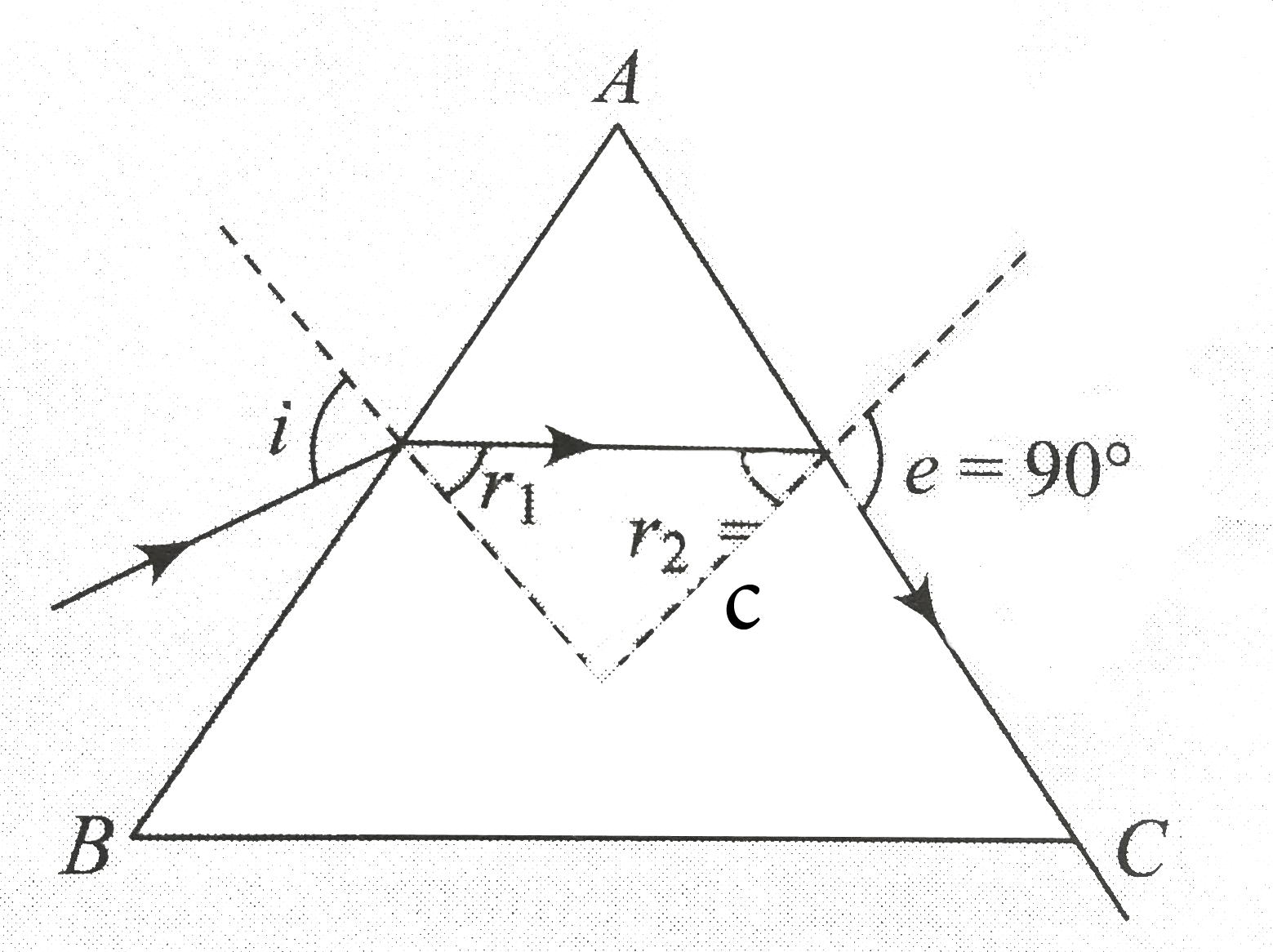In an experiment for determination of refractive index of glass of a prism by , plot it was found thata ray incident at angle , suffers a deviation of and that it emerges at angle . In that case which of the following is closest to the maximum possible value of the refractive index?
1.6
1.7
1.8
1.5
The correct Answer is:D
To solve the problem of determining the maximum possible value of the refractive index of a glass prism based on the given angles, we can follow these steps:
1. Understand the Given Values:
- Angle of incidence (I) = 35°
- Angle of emergence (E) = 79°
- Angle of deviation (Δ) = 40°
2. Use the Deviation Formula:
The formula for deviation (Δ) in a prism is given by:
Δ=I+E−A
where A is the angle of the prism.
3. Rearranging the Deviation Formula:
We can rearrange the formula to find the angle of the prism (A):
A=I+E−Δ
4. Substituting the Values:
Plugging in the values we have:
A=35°+79°−40°
A=114°−40°=74°
5. Finding the Refractive Index (μ):
The maximum possible value of the refractive index (μ) for a prism can be calculated using the formula:
μ=sin(A+I2)sin(A2)
6. Calculating the Angles:
First, calculate A+I2 and A2:
- A+I=74°+35°=109°
- A+I2=109°2=54.5°
- A2=74°2=37°
7. Calculating the Sine Values:
Now, we calculate the sine values:
- sin(54.5°)
- sin(37°)
Using a calculator or sine tables:
- sin(54.5°)≈0.8192
- sin(37°)≈0.6018
8. Substituting into the Refractive Index Formula:
Now substitute these values into the refractive index formula:
μ=0.81920.6018≈1.36
9. Conclusion:
The maximum possible value of the refractive index is approximately 1.36. The closest option to this value is 1.4.
Final Answer:
The closest maximum possible value of the refractive index is 1.4.
- Angle of incidence (I) = 35°
- Angle of emergence (E) = 79°
- Angle of deviation (Δ) = 40°
The formula for deviation (Δ) in a prism is given by:
Δ=I+E−A
where A is the angle of the prism.
We can rearrange the formula to find the angle of the prism (A):
A=I+E−Δ
Plugging in the values we have:
A=35°+79°−40°
A=114°−40°=74°
The maximum possible value of the refractive index (μ) for a prism can be calculated using the formula:
μ=sin(A+I2)sin(A2)
First, calculate A+I2 and A2:
- A+I=74°+35°=109°
- A+I2=109°2=54.5°
- A2=74°2=37°
Now, we calculate the sine values:
- sin(54.5°)
- sin(37°)
- sin(54.5°)≈0.8192
- sin(37°)≈0.6018
Now substitute these values into the refractive index formula:
μ=0.81920.6018≈1.36
The maximum possible value of the refractive index is approximately 1.36. The closest option to this value is 1.4.
The closest maximum possible value of the refractive index is 1.4.
Topper's Solved these Questions
Similar Questions
The angle of a prism is 30∘. The rays incident at 60∘ on one refracting face suffer a deviation of 30∘. Then the angle of emergence is :
View SolutionThe angle of a prism is 30∘. The rays incident at 60∘ on one refracting face suffer a deviation of 30∘. Then the angle of emergence is :
View SolutionA light ray is incident perpendicularly to one face of a 90∘ prism and is totally internally reflected at the glass-air interface. If the angle of reflection is 45∘, we conclude that the refractive index n

View SolutionWhat should be the minimum value of refractive index of a prism, refracting angle A, so that there is no emergent ray irrespective of the angle of incidence?

View SolutionFor a prism kept in air, it is found that for an angle of incidence 60∘, the angle of refraction A, angle of deviation δ and anble of emergence e become equal. Then, the refractive index of the prism is
View SolutionA prism of refractive index sqrt2 has refractive angle 60∘. In the order that a ray suffers minimum deviation it should be incident at an angle of
View SolutionDefine refractive index of a transparent medium. A ray of light passes through a triangular prism. Plot a graph showing the variation of angle of deviation with the angle of incidence.
View SolutionThe refractive index of the material of a prism is 1.5 and its refracting angle is 6º. Find the deviation produced by the prism for a small angle of incidence.
View SolutionThe refractive index of the material of a prism is 1.5 and its refracting angle is 6º. Find the deviation produced by the prism for a small angle of incidence.
View SolutionA ray of light is incident on a rectangular plate at an angle of incidence 60∘. The light ray suffers a deviation which is 25% of the angle of incidence. The refractive index of the glass will be
View Solution
